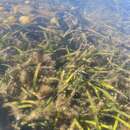pt-BR
nomes no trilho de navegação


Posidonia australis, also known as fibre-ball weed or ribbon weed, is a species of seagrass that occurs in the southern waters of Australia. It forms large meadows important to environmental conservation. Balls of decomposing detritus from the foliage are found along nearby shore-lines.
In 2022, a single stand in Shark Bay was reported by scientists to not only be the largest plant in The world, but the largest organism by square size.[2]
Posidonia australis is a flowering plant occurring in dense meadows, or along channels, in white sand. It is found at depths from 1–15 m (3–49 ft). Subsurface rhizomes and roots provide stability in the sands it occupies. Erect rhizomes and leaves reduce the accumulation of silt.
The leaves are ribbon-like and 11–20 mm (0.43–0.79 in) wide. They are bright green, perhaps becoming browned with age.[3] The terminus of the leaf is rounded or absent through damage. They are arranged in groups with older leaves on the outside, longer and differing in form from the younger leaves they surround.
The species is monoecious. The flowers appear on small spikes on leafless stems, two bracts on each spike. The plant pollinates by hydrophily, by dispersing in the water.[4]
Posidonia australis reproduction usually occurs through sexual or asexual methods but, under extreme conditions, by pseudovivipary.[5]
A 2013 study showed that P. australis can sequester carbon 35 times more efficiently than rainforests.[6]
In 2022, a study by the School of Biological Sciences and Oceans Institute at The University of Western Australia showed that a single plant of this species can grow vegetatively by using rhizomes to cover an extensive area, similar to buffalo grass. This particular specimen has double the number of chromosomes of other studied populations (40 chromosomes instead of the usual 20).[7]

This species is found in waters around the southern coast of Australia. In Western Australia it occurs in the Shark Bay region, around islands of the Houtman Abrolhos, and southward along the coast of the Swan Coastal Plain. The species is recorded at the edge of the Esperance Plains, the Archipelago of the Recherche, at the southern coast of the southwest region. The range extends to the east to coastal areas of New South Wales, South Australia, Tasmania, and Victoria.[4]
A sign of a nearby occurrence of Posidonia is the presence of masses of decomposing leaves on beaches, forming fibrous balls.
A research article in the Proceedings of the Royal Society[8] reported in June 2022 that genetic testing had revealed that samples of Posidonia australis taken from a meadow in Shark Bay up to 180 km (110 miles) apart were all from a single clone of the same plant. The plant covers an area of seafloor of around 200 km2 (49,000 acres).[9] This would make it the largest known organism in the world by area, exceeding the size of a colony of the Armillaria ostoyae fungus in Malheur National Forest, Oregon that extends 9.1 km2 (2,000 acres), as well as a stand of quaking aspen trees in Utah that extends over more than 40 ha (100 acres).[9]
The plant is estimated to have taken at least 4,500 years[8] to grow to this size by using rhizomes to colonise new parts of the seafloor, assuming a rhizome growth rate of around 35 cm (14 in) a year.[10][9] This age puts it among the oldest known clonal plants too.
This species is a member of the family Posidoniaceae, one of eight occurring in Australia. The ninth member, Posidonia oceanica, is found in the Mediterranean sea. The genus name for this species, Posidonia, is given for the god of the seas Poseidon, and australis refers to the southern distribution.
The species was first described by Joseph Hooker in Flora Tasmaniae.[11] Common names for the plant include fibre-ball weed and ribbon weed.[9]
IUCN lists this species as "near threatened",[1] while the meadows in New South Wales have been listed by the Commonwealth of Australia as an endangered ecological community since 2015.[12]
Posidonia australis, also known as fibre-ball weed or ribbon weed, is a species of seagrass that occurs in the southern waters of Australia. It forms large meadows important to environmental conservation. Balls of decomposing detritus from the foliage are found along nearby shore-lines.
In 2022, a single stand in Shark Bay was reported by scientists to not only be the largest plant in The world, but the largest organism by square size.
Posidonia australis
La Posidonie australienne (Posidonia australis) est une espèce de plante aquatique de la famille des Posidoniaceae, et forme des herbiers dans les eaux au sud de l'Australie.
Posidonia australis
La Posidonie australienne (Posidonia australis) est une espèce de plante aquatique de la famille des Posidoniaceae, et forme des herbiers dans les eaux au sud de l'Australie.
Posidonia australis, vrsta porosta (posidonije), morskih jednosupnica koje obitavaju u vodama oko južne obale Australije[1]. Ova vrsta čini na dubinama od jednog pa do 15 metara velike livade za koje se smatra da su od velike važnosti za očuvanje okoliša.
Rizomi su ukopani u pjeskovito dno, a listovi su trakastog oblika, široki 11 do 20 mm., svjetlozelene boje, koji kasnije dobiju smeđu boju.
Znak prisutnosti ove vrste su vlaknaste kugle koje more izbaci na obalu, po čemu je ova vrsta vernakularno postala poznata kao fibreball weed.
Na Zajedničkom poslužitelju postoje datoteke vezane uz: Posidonia australis Wikivrste imaju podatke o: Posidonia australisPosidonia australis là một loài thực vật có hoa trong họ Posidoniaceae. Loài này được Hook.f. miêu tả khoa học đầu tiên năm 1858.[1]
Posidonia australis là một loài thực vật có hoa trong họ Posidoniaceae. Loài này được Hook.f. miêu tả khoa học đầu tiên năm 1858.
澳大利亚海神草(学名:Posidonia australis)又名波喜荡或澳洲波喜荡,为海神草科海神草属下8种分布于澳大利亚的植物之一。
澳大利亚海神草只分布于澳大利亚中部到南部的沿海地区[1],虽然之前有在中国发现的记录,却只是鉴定错误[2]。
|url=为空 (帮助); 使用|accessdate=需要含有|url= (帮助)